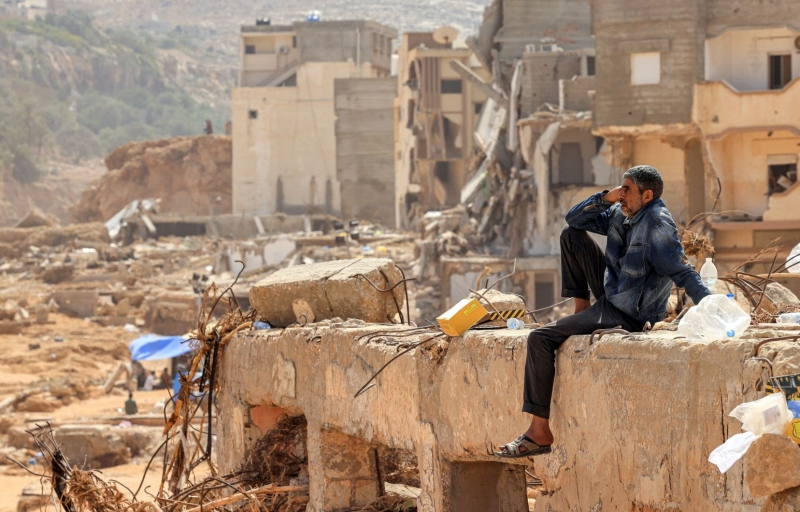
Karim Sahib Agence France-Presse A survivor among the ruins, in Derna. According to a latest report, the disaster in Libya left 3,283 dead. The final toll could be much higher due to the number of missing people, who number in the thousands.
It was two o'clock in the morning when Abdel Moneim Awad Al-Sheikh heard screams. Jumping out of his bed, he discovers that the water is spreading everywhere, then waves tear off the doors of his house in Derna, carrying away everything in their path.
The torrential rains fell on this town of eastern Libya on the night of September 10-11 led to the collapse of two dams, causing a tsunami-sized wave along a usually dry wadi.
Standing in front of the stairs of his destroyed house, staring at the landscape of devastation spread out before him, Abdel Moneim remembers how he and his family survived the catastrophe that left thousands dead and missing.
“I left the house and took nothing with me except my glasses and my cell phone. I went out and the water was shaking the iron doors,” the 73-year-old man told AFP.
Also read
- Libya flood disaster seen from space
- Overheating sea and political chaos behind Libya floods
- UN fears a spread of diseases in Derna
Parts of the city including buildings and infrastructure were wiped off the map, and according to residents, most of the victims were buried under mud or carried towards the Mediterranean.
On Sunday, at the port of Derna, Turkish and Russian divers were still searching for bodies, a week after the disaster. Not far from them, other Emirati and Libyan rescuers were meeting to “coordinate” their operations.
Between Abdel Moneim’s house and the wadi, “there were three or four buildings . Today, there is nothing left. Just dirt. It’s as if there were no buildings here,” he laments.
Today, the floor of his house, on the first floor, is covered with a thick layer of dry earth, the windows are devastated, sections of walls are cracked or destroyed. He lived there with his wife. His two sons and their families occupy the other floors of the building.
When the door to their house was destroyed by the powerful floods, they went up to the fourth floor. But that wasn’t the end of their “nightmare.”
After a quarter of an hour, says Abdel Moneim, “my son shouted to say that another wave was coming and that it was bigger than the first, about 20 meters high.”
< h2 class="h2-intertitre">On the roof until dawn
He said that he and his people had been forced to climb even higher, to the fifth floor, on the roof of the his neighbor's house.
“We used a wooden ladder and stayed until dawn when young volunteers came to help us. »
Like Abdel Moneim, many families in Derna experienced the same nightmare.
Mohamad Abdelhafidh, a Lebanese resident in Derna, told AFP he “saw death”. He was sleeping when he felt a “shake.” “I thought it was an earthquake.”
He then asked his sister and his father to go down to the street, but from his balcony, he discovered that the water had risen to 'at his apartment, on the third floor.
He says that he and members of his family went to the upper floors where they stayed until the water level dropped.
According to a latest report communicated by the Ministry of Health of the government based in the east of the country divided, the disaster left 3,283 dead. The final toll could be much higher due to the number of missing people numbering in the thousands.
“The day before [the disaster], we had received warnings that heavy rains were expected and that we had to stay at home. Nothing else,” recalls Mohammed Al-Zawi, 25.
Surprised by the waves, the bearded young man told AFP he survived with his family of nine by climbing onto the roof from their two-story house.
As soon as the water level dropped, he said he went out into the street and saw 25 to 30 bodies before rushing to the survivors to help them .
“The water swept away cars with people inside, people and property. Everything was dumped into the sea,” he recalls, still in shock.

